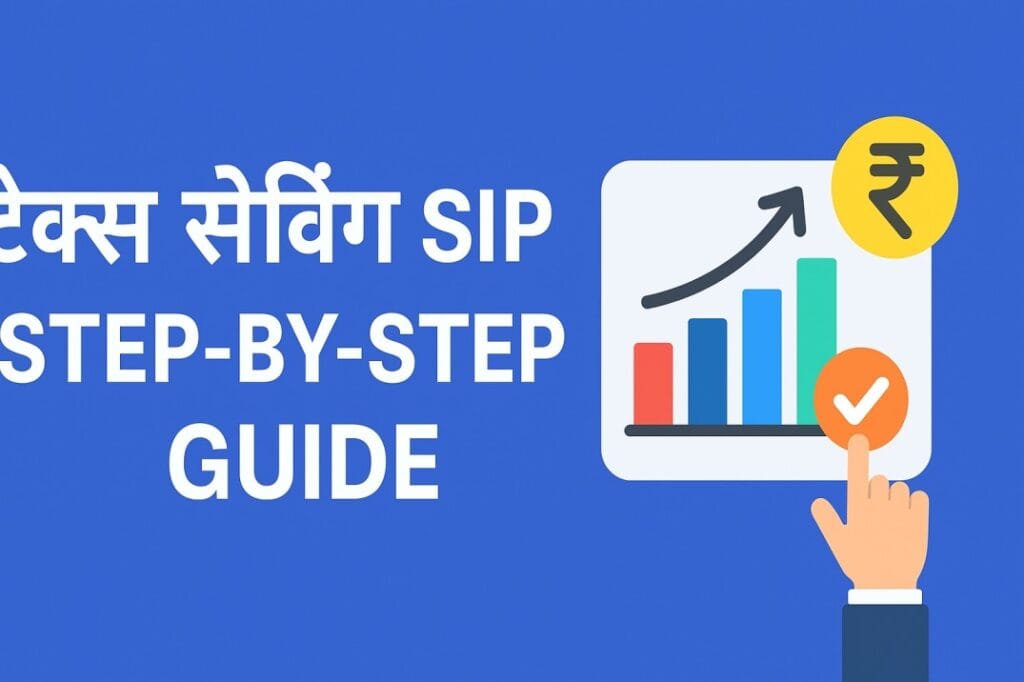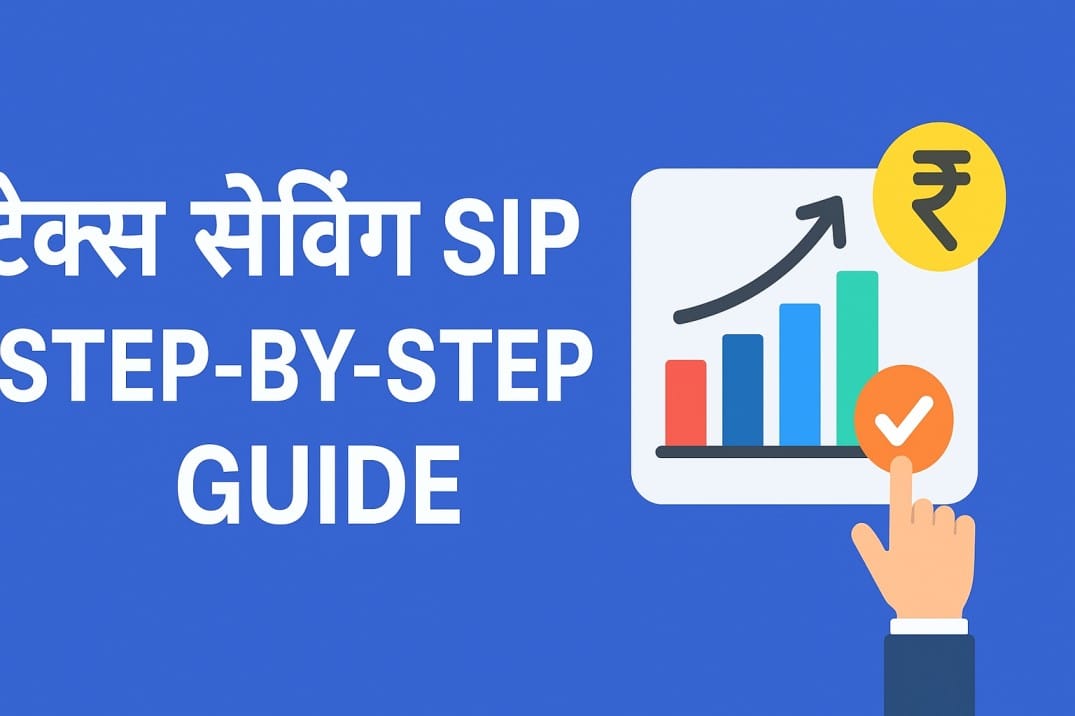Introduction
Agar aap financial dunia mein naye ho ya experienced investor ho, to Tax Saving SIP ek aisa tool hai jo dono cheez—kar bachat aur wealth creation—ek saath karta hai. Is guide mein main simple Hinglish mein samjhaunga kya hai, kaise kaam karta hai, kaunse funds chunna chahiye, aur practical step-by-step plan jo aap aaj se follow kar sakte ho. Yeh article SEO friendly, unique aur practical tips se bhara hua hai — bina jyada jargon ke.

1) Tax Saving SIP kya hota hai?
Tax Saving SIP formally woh systematic investment plan hai jo ELSS (Equity Linked Savings Scheme) type mutual funds ke through kiya jata hai. ELSS funds ko invest karne par aapko Section 80C ke tahat tax benefit milta hai. SIP ka matlab hota hai regular, chhote investments (jaise monthly), jo discipline aur rupee cost averaging dono provide karte hain.
Simple shabdon mein: aap regular chhote amounts ELSS funds mein daalte ho, jo long term mein grow karte hain, aur aapko tax ke roop mein deduction bhi milta hai.
2) ELSS aur Section 80C — basics
- ELSS: Equity-based mutual fund jo stock market mein invest karta hai. Iska unique feature hota hai lock-in period (generally 3 saal).
- Section 80C: Income Tax Act ke part jisme aap up to ₹1.5 lakh tak ka annual deduction claim kar sakte ho (example: PPF, EPF, ELSS, LIC premium, etc.).
- ELSS ko choose karke aap 80C ka portion fill kar sakte ho jo taxable income kam kar deta hai.
3) Kaise kaam karta hai — mechanism (stepwise samjho)
- Aap mutual fund house mein ELSS fund select karte ho.
- SIP mode choose karke monthly amount set karte ho (₹500 se start hota hai usually).
- Har month aapke bank se amount deduct hota hai aur fund units milte hain.
- Units ka NAV market moves ke saath change hota hai; long term mein potential growth possible hota hai.
- Lock-in period ke complete hone ke baad aap redemption kar sakte ho aur tax benefit claim kar sakte ho.
4) Major benefits (faayde)
- Kar bachat + growth: Ek hi instrument se aap deduction bhi le sakte ho aur equity upside ka benefit bhi.
- Short lock-in (3 saal): Compared to other 80C options, ELSS ka lock-in generally sabse chhota hota hai.
- Systematic investing habit: SIP discipline se regular investing hoti hai, emotional timing se bachata hai.
- Potential higher returns: Equity exposure ke karan long term returns fixed income se zyada ho sakte hain.
5) Risks aur limitations (nuksan / kya dekhe)
- Market risk: Agar market down rahe to NAV gir sakta hai; short term mein loss ho sakta hai.
- No guaranteed returns: Mutual funds equity instruments pe depend karte hain—returns variable hote hain.
- Lock-in: 3 saal ke andar withdraw nahi kar sakte (emergency mein liquidity issue).
- Tax on gains: Lock-in ke baad agar profit hua to long-term capital gains rules apply honge (limit ke baad tax lag sakta hai).
6) Kaise choose kare best ELSS fund — practical checklist
- Fund history dekho: 5 saal se upar consistent performance check karo (long term dekho).
- Fund manager experience: Jo manager market cycles handle kar chuka ho, usko prefer karo.
- Expense ratio: Kam kharch wala fund zyada net returns dega.
- Alpha aur volatility: Consistent alpha aur manageable volatility sign of good fund.
- Portfolio diversification: Sector concentration bahut zyada na ho.
- Exit aur lock-in policy: Redemption rules samjho.
- AUM (Asset under management): Bahut small aur bahut large dono ko pros/cons se dekho.
7) SIP amount kaise decide kare (goal based approach)
- Step A — Goal fix karo: Retirement, ghar, bachchon education—jo bhi.
- Step B — Time horizon dekho: Har goal ke liye required years note karo.
- Step C — Risk capacity samjho: Aggressive ho to equity heavy; conservative to mix.
- Step D — SIP calculator use karo: Expected return assumption dal ke required monthly amount milta hai.
- Tip: Start small (₹500–₹2,000) aur jaise income bade, SIP amount badhao.
8) Step-by-step: Tax Saving SIP start karne ka practical plan
Step 1 — Financial review
Apni income, expenses aur emergency fund check karo. SIP shuru karne se pehle 3–6 months ka emergency hona chahiye.
Step 2 — Goal set karo
Short-term aur long-term goals alag karo. ELSS mainly tax saving + mid-long term growth ke liye best hai.
Step 3 — Fund research
Top 3 ELSS funds short-list karo using checklist (performance, expense, manager).
KYC Process (Step 4) — KYC complete karo
Agar pehle se KYC nahi hai to mutual fund KYC complete karo — PAN aur Aadhaar link karna hota hai.
SIP Setup (Step 5): — SIP amount aur date set karo
Monthly amount choose karo aur auto-debit mandate lagao taaki discipline bana rahe.
Performance Check (Step 6) — Monitor quarterly
Har 3–6 mahine fund performance dekhte raho; emotional reaction se avoid karo.
SIP Increase (Step 7) — Increase periodically
Salary badhne par SIP amount step-up karo; inflation ko beat karne ke liye zaroori.
Portfolio Review (Step 8) — Lock-in ke baad re-assess
3 saal ke baad portfolio review karo: hold, top-up, ya switch decision lo.
9) Example calculation (simple aur practical)
Maan lo aap ₹2,000 per month SIP karte ho ELSS mein. Annual contribution = ₹24,000. Agar aap 3 saal continuous invest karte ho to total contribution ₹72,000. Assumed average annual return 12% (equity assumption) to approximate maturity value kuch is tarah se hoga (compounding effect ke saath):
- After 3 years approximate corpus ≈ ₹86,000–₹95,000 (estimate; market dependent).
Agar aap ₹12,500 per month (₹1.5 lakh annually) invest karte ho to Section 80C limit cover ho jayegi. Ye example sirf understanding ke liye hai — exact numbers market returns pe depend karte hain.
10) Tax implication aur filing tips
- ELSS contribution ka deduction Section 80C mein claim hota hai. Deduction limit ₹1.5 lakh per financial year (aggregate across instruments).
- Redemption par agar long-term capital gains threshold cross hota hai to taxable ho sakta hai (current rules ke hisab se threshold aur rates apply hote hain).
- SIP slips aur account statements tax filing ke liye safe rakhna—mutual fund statements ko download kar ke folder mein rakhlo.
11) Common mistakes jo avoid karne chahiye
- Market timing karna: SIP ka faida discipline se milta hai; timing se bachna chahiye.
- Short term pressure: 3 saal ka lock-in hota hai; chhote downturns par panic sell na karo.
- Single fund pe over-exposure: Diversify across few funds agar zaroorat ho.
- Ignoring expense ratio: High fees long term mein returns ghatate hain.
- Not increasing SIP: Salary update ke baad SIP amount update karna bhool jaate hain.
12) Frequently Asked Questions (FAQ)
Q1: SIP kab start karna chahiye?
A: Jitni jaldi possible ho — time market ka friend hota hai. Agar aapka emergency fund ready hai to invest start kar do.
Q2: Kya ELSS safest instrument hai?
A: Nahi. Equity exposure hota hai isliye market risk hota hai. Par long term mein potential achha ho sakta hai.
Q3: Kya mujhe lumpsum ya SIP choose karna chahiye?
A: Agar paas large savings ho aur market entry time frame samajh lo to lumpsum consider kar sakte ho; otherwise SIP better hai for discipline.
Q4: Kya main multiple ELSS funds mein invest kar sakta hoon?
A: Ha, diversification ke liye 2–3 funds rakhna achha hota hai; lekin bahut zyada funds manage karna mushkil hota hai.
Q5: Exit ka best time kaise pata karun?
A: Financial goal complete hone par ya fund consistent underperform kar raha ho to consider exit after lock-in.
13) Practical tips to boost success
- Auto-debit lagao: Discipline maintain hota hai.
- SIP inflation adjust karo: Har saal 10% step-up consider karo.
- Emergency fund pehle: Pehle 3–6 mahine ka fund ready rakho.
- Long term mindset: Equity ka magic long horizon mein zyada kaam karta hai.
- Rebalance saal mein ek baar: Portfolio drift agar ho to rebalance karo.
14) Final checklist before start
- KYC done?
- Emergency fund ready?
- Goals list ready?
- Fund short-list complete?
- SIP mandate set?
Agar haan, to aap ready ho Tax Saving SIP shuru karne ke liye.
Conclusion
Tax Saving SIP ek pragmatic aur disciplined tareeka hai jo kar bachat aur wealth building dono offer karta hai. Agar aap systematic approach follow karte ho — goals set karna, fund research, SIP discipline aur periodic review — to yeh instrument long term mein kaafi faayda de sakta hai. Hamesha yaad rakho: market ups and downs normal hain; patience aur plan sabse bada asset hai. Agar aap ready ho to chhote se start karo, regular review karo aur jaise income badhe SIP ko grow karo — is tarah aap both tax benefit aur corpus creation achieve kar paoge.


1 thought on “Tax Saving SIP: 7 Steps to Start and Save More”